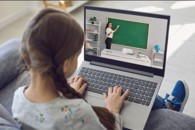
Think about the following questions.
1. Were you able to continue studying or working during the COVID-19 pandemic?
2. If so, how did you manage to keep working or studying? What tools or techniques did you use?
3. Do you feel that your education or work suffered? If so, why?
VOCABULARY PREVIEW
Match each New Academic Word List(NAWL) word with the correct definition.
- generalize
- closure _____
- occupation _____
- behavioral _____
- innate_____
- continuity _____
- a. a long-term job; a type of employment
- b. relating to the way people act or what they do
- c. the act of an organization or building closing or not operating
- d. built into someone or something; there from the start
- e. the state of something staying as it is without changing or stopping
- f. to say that something is always true when it is only true in some cases or some of the time
CLOSED DOORS: EDUCATION UNDER COVID-19

When the COVID-19 pandemic struck in early 2020, politicians faced many difficult choices. One of their hardest decisions was whether or not to close schools; it soon became apparent that they had no choice. According to the UN, at the peak of the pandemic that year, an estimated 1.6 billion children were affected by school closures.
Some families found that homeschooling was a useful substitute1 for attending school in person. Parents who worked in white-collar office jobs were often able to work from home. This meant they could homeschool their children daily and maintain2 some educational continuity. Some parents said they appreciated the chance to spend more time with their children and be involved with their education. While we cannot generalize, it is likely that these parents had a fairly high level of education and thus were able to tutor their children to a relatively high standard.
For parents who worked in blue-collar (manual) occupations, homeschooling was often not feasible3. It is impossible for bus drivers or factory, construction, and healthcare workers to work from home. Instead, many were forced to continue going out to work and were therefore unable to homeschool their children. In fact, they were often left with the challenge of finding someone to care for their children during the day. In countries like the UK, some blue-collar employees were identified as "key workers," and their children were allowed to attend school as part of small classes.
Remote learning also reduced some effects of school closures. Many teachers used programs like Zoom or Google Classroom to teach and monitor their pupils' progress. Features on these programs allowed teachers to set tasks, share books and films, and give students advice. But if parents were not present, it was often difficult to ensure that work was being done. For some children, it was not only working parents that made remote learning less feasible. Many did not have access to computers at all or lacked the money to buy essential books. In some countries, under normal conditions, public libraries provide these for free, but unfortunately, libraries were also closed due to the virus4.
School closures had some negative consequences for all students. Schools are not only centers for formal education but are also crucial5 to behavioral development; they are where we learn to interact, socialize, and share. At school, we form relationships that can define6 our lives for years to come. During the pandemic, those with access to computers or smartphones could use social media to replace some of these interactions. But, again, this did not include all students. Also, teachers are trained professionals7; all children benefit from exposure to the personal guidance they give; without it, any child is at risk of developing more slowly. On top of this, many less-fortunate children rely on free school meals. While at home, many were not able to eat well, or eat enough. Without sufficient nutrition8, their physical and intellectual9 development may have suffered even more.
While life was difficult enough for many families during school closures, it may take years to see the long-term effects. Already at an innate disadvantage, many poorer children may have fallen further behind. This will reduce their chances of attending university and getting well-paid jobs, so the cycle10 of disadvantage will continue. Some parents were able to create a fairly smooth and short path through the COVID-19 pandemic. For others, the journey is likely to be much rougher-and far longer.
New Academic Word List
- substitute 1 : n. a thing or person which is used instead of another; a replacement
- maintain 2 : v. to continue to have; to keep; to prevent from reducing
- feasible3 : adj. able to be done or made
- virus 4 : n. a disease that spreads between people or animals
- crucial 5 : adj. extremely important or necessary
- define 6 : v. to say what something is or what its limits are
- professional 7 : n. someone who does a skilled job
- nutrition8 : n. the process of eating the right kind of food so you can grow properly and be healthy
- intellectual 9 : adj. relating to thinking and understanding
- cycle10 : n. a group of events that follow each other and often repeat
READING COMPREHENSION
A ‣ Mark each statement as true (T) or false (F) according to the reading.
- White-collar workers were often able to spend more time with their children.
- True
- False
- Most parents who homeschooled probably had fairly little education.
- True
- False
- Public libraries were able to help many students during the COVID-19 pandemic.
- True
- False
- Some children's health suffered because they couldn't attend school.
- True
- False
- We can only see some of the effects of school closures today.
- True
- False
B ‣ Choose the best answer according to the reading.
- What is the main topic of the reading?
- a. The value of teachers to society
- b. The benefits of homeschooling
- c. The unequal effects of COVID-19
- d. The use of technology during COVID-19
- Why were some children in the UK allowed to attend school?
- a. Their parents were blue-collar workers.
- b. Their parents were white-collar workers.
- c. Their parents were professionals.
- d. Their parents were key workers.
- What can be inferred from paragraph 4?
- a. Students with parents working outside the home fell behind in their studies.
- b. Schools provided some students with learning resources such as computers.
- c. Many children went to local libraries to get access to computers and books.
- d. Teachers found that it was easier to teach remotely than in the classroom.
- In paragraph 6, the word smooth means
- a. enjoyable
- b. flat
- c. easy
- d. confident
C ‣ Fill in the blanks with information from the reading.
- _____ programs like Google Classroom helped teachers keep track of their students' progress.
- Poorer students couldn't afford to buy _____.
- Some students rely on free school _____ for nutrition.
SUMMARY
Fill in the blanks with the phrases in the box.
- continue their education
- permanent disadvantage
- access to computers
- monitor their pupils
- to close schools
- remote-learning tools
As the COVID-19 pandemic spread around the world in 2020, many governments decided 1 _____ to help protect their populations. This meant that children had to study at home with the help of their parents and 2 _____.Teachers used tools such as Google Classroom to teach and 3 _____ during the closures. However, some children from less-wealthy families did not have 4 _____. And because libraries were closed, these children could also not get hold of the books they needed. Although children from wealthier families were able to 5 _____ relatively successfully during the pandemic, it may take years for less-wealthy children to catch up. And some may even find themselves at a 6 _____.
VOCABULARY PRACTICE
Fill in the blanks with the words in the box. Change the form if necessary.
- innate
- behavioral
- closure
- generalize
- continuity
- occupation
- It is important not to _____ about the citizens of a country; people have different ideas and attitudes.
- The company had three different managers this year, so there was no _____.
- Doctor and lawyer are two examples of well-paid _____.
- A recent _____ study aims to find out how people react to stressful situations.
- People with a(n) _____ leadership ability find it easier to get promoted.
- The _____ of coal mines and factories led to high levels of unemployment.
SUPPLEMENTAL READING
Helping Hands

The COVID-19 pandemic closed schools all over the world. While some families were better equipped to cope with the resulting problems, others struggled. To try and help, individuals and communities responded in a variety of ways.
England and Manchester United soccer player Marcus Rashford knows how important free school lunches are. Although now a successful athlete, he relied on them as a child. So he used his public profile and huge number of Twitter followers to draw attention to the problem. The British government responded by agreeing to give free meals to some students for a brief period. Rashford asked that they extend the program to cover the period of the pandemic. The government refused, but many food companies and restaurants agreed to provide food to less-wealthy children for free. Rashford promised to continue his mission to provide free lunches to 1.4 million of the UK's poorest children.
Meanwhile, students at Stanford University acted to address the fact that eleven million children in the US did not have access to a laptop or computer; for these children, remote learning was impossible. So Margot Bellon and Isabel Wang founded the non-profit organization Bridging Tech. They used a nationwide network of volunteers to collect used, unwanted laptops and deliver them to children who needed them. During COVID-19, this allowed less-wealthy children to participate fully in remote learning and online study. The pair chose the name because they aim to bridge the "digital divide" between rich and poor, a gap that the COVID-19 pandemic only widened.
Fill in the blanks with information from the reading.
- Marcus Rashford asked the _____ to provide free school lunches.
- Restaurants and _____ responded to Rashford's request for food for children in need.
- Margot Bellon and Isabel Wang founded their company to bridge the _____.

Leave a comment
Load more